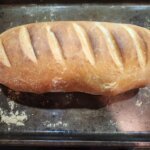There’s nothing quite like the smell of warm, soft bread coming out of the oven. This soft bread recipe is one of those simple, satisfying staples that every home baker should have. Whether you’re making sandwiches, toast, or just enjoying a slice with butter, this soft homemade bread will quickly become a favourite in your kitchen.
This post may contain affiliate links. If you use these links to buy something we may earn a commission. Thanks.
Here at dbsfarmwilson, we bake this bread regularly. It’s easy, reliable, and tastes so much better than store-bought loaves that we’ll never buy bread again. This soft bread recipe uses a 69% hydration level (more on this later) that is perfect for homemade bread.
Why You’ll Love This Soft Bread Recipe
If you’ve been looking for a foolproof way to make bread that’s light, fluffy, and soft, this is it.
- Simple ingredients you already have in your pantry
- Perfect texture, soft on the inside, golden on the outside
- Ideal for sandwiches, French toast, or dinner sides
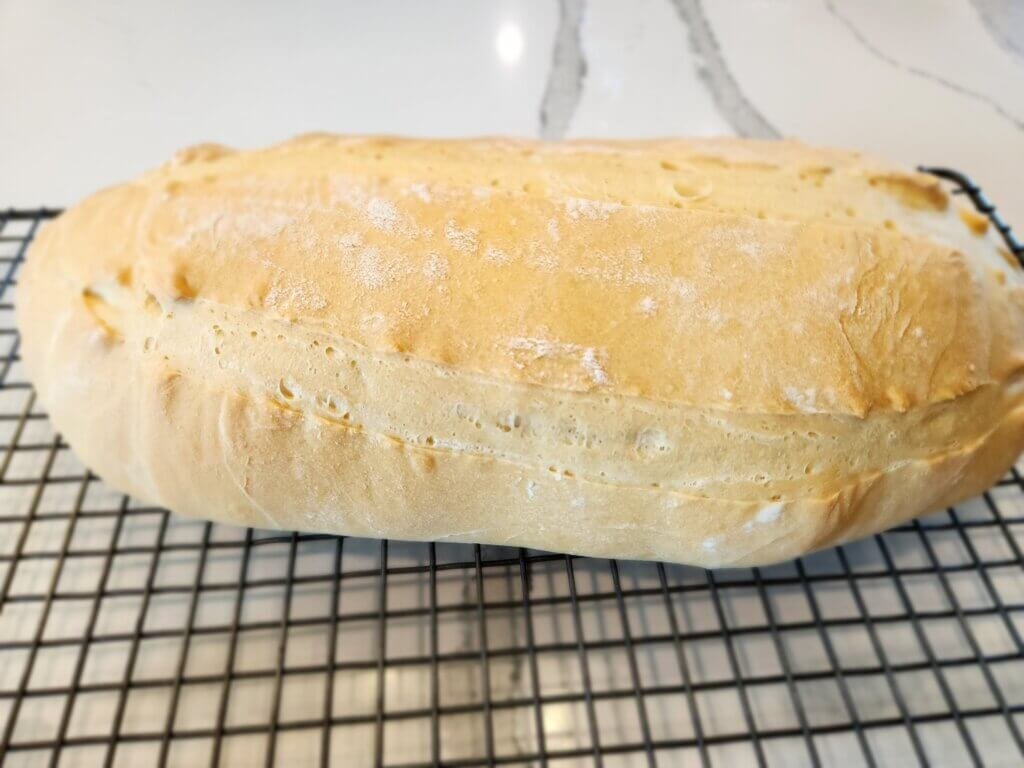
You will be hard pressed to not eat the whole loaf of this soft homemade bread in one day, every time you make it.
Ingredients You’ll Need
- 480g all-purpose or bread flour
- 80g (about 1/3 cup) milk
- 250g (about 1 cup) warm water
- 8g active dry yeast (1 packet)
- 5g sugar
- 5g salt
- 30g butter

Butter adds flavour and keeps your soft homemade bread moist and tender. Milk helps create a richer crumb and softer crust.
Step-by-Step: How to Make Soft Homemade Bread
1. Activate the Yeast (Optional Step)
In the mixing bowl of a stand mixer, or large bowl, combine warm water, milk and sugar. Stir in the yeast and let it sit for about 5–10 minutes until it’s frothy. This ensures your yeast is active and ready to help your dough rise.
This is only necessary when you are unsure if your yeast is active. If you make bread all the time like we do, we know the yeast we use is active so we can skip this step.
2. Mix and Knead
Add the rest of the ingredients (butter, salt, and flour) to the bowl. If using a stand mixer, mix on speed 2 for 5 minutes until the dough is combined and fairy smooth.
If you are not using a stand mixer, stir to combine the ingredients. Pour onto a clean work surface and knead for about 8–10 minutes until the dough is smooth and elastic.
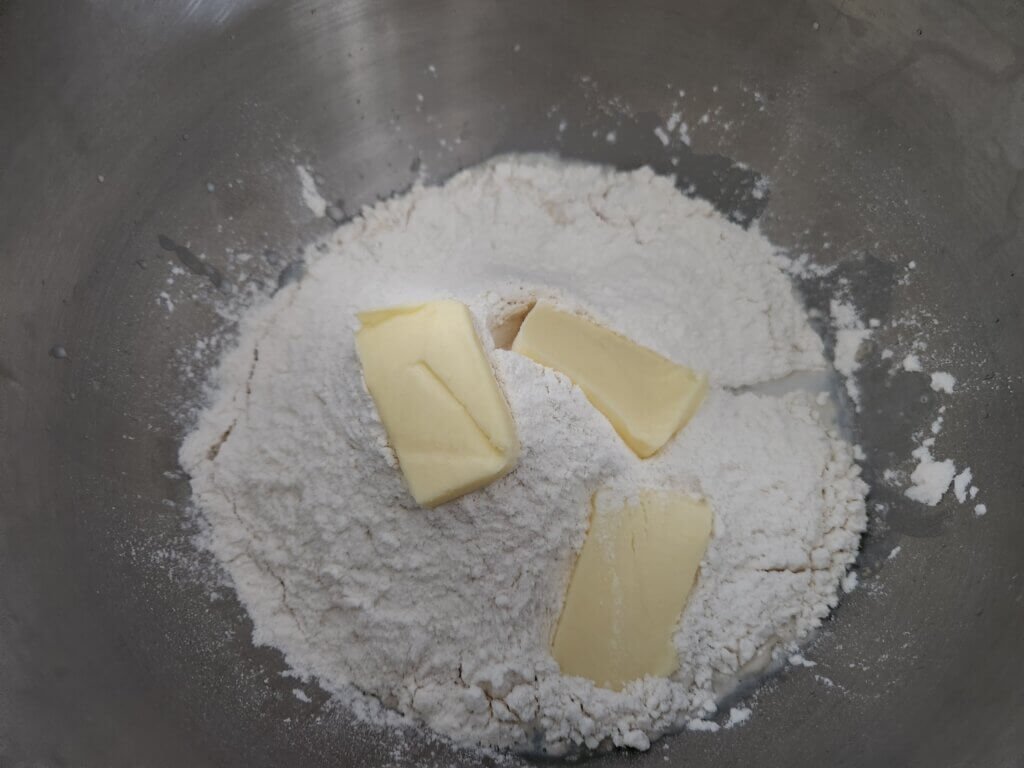
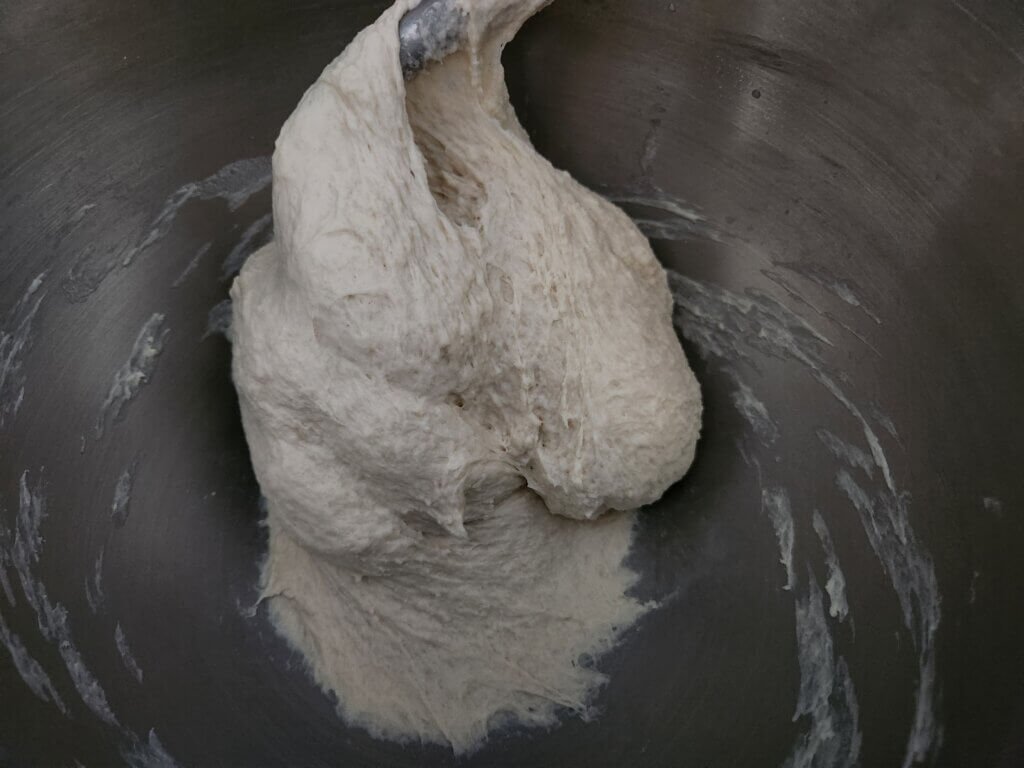
Remove the dough from the stand mixer using a spatula and place onto a floured surface. Knead the dough for a few seconds until is becomes very smooth and form it into a ball. This will help gluten development by building tension and give better structure to the dough.
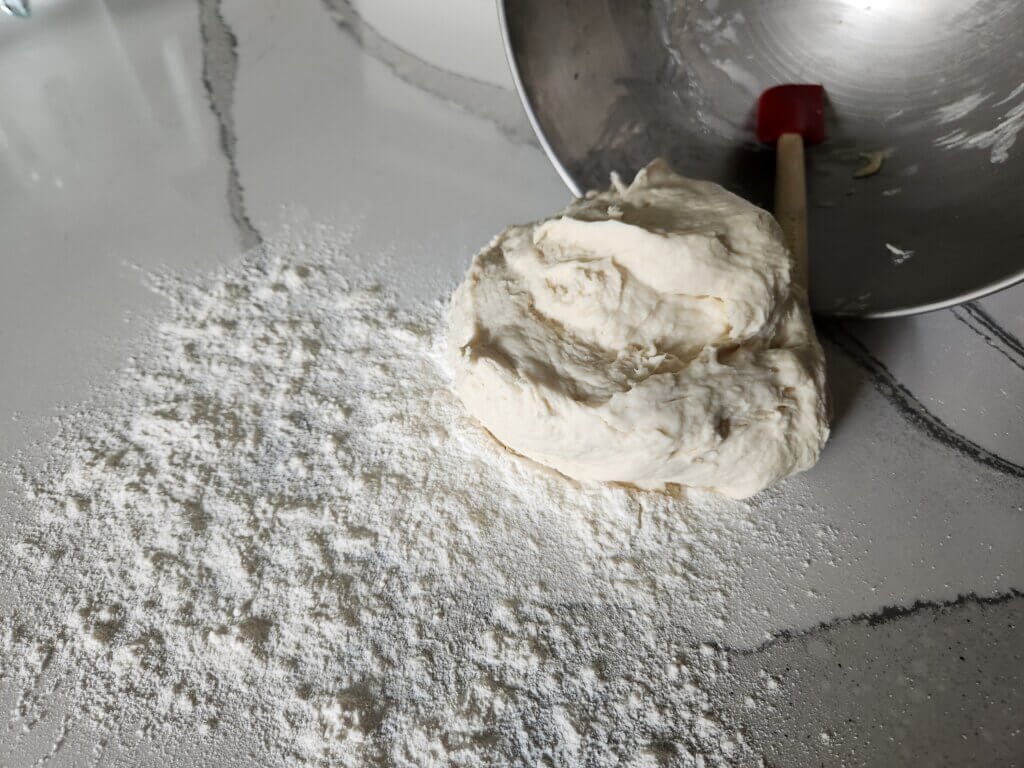
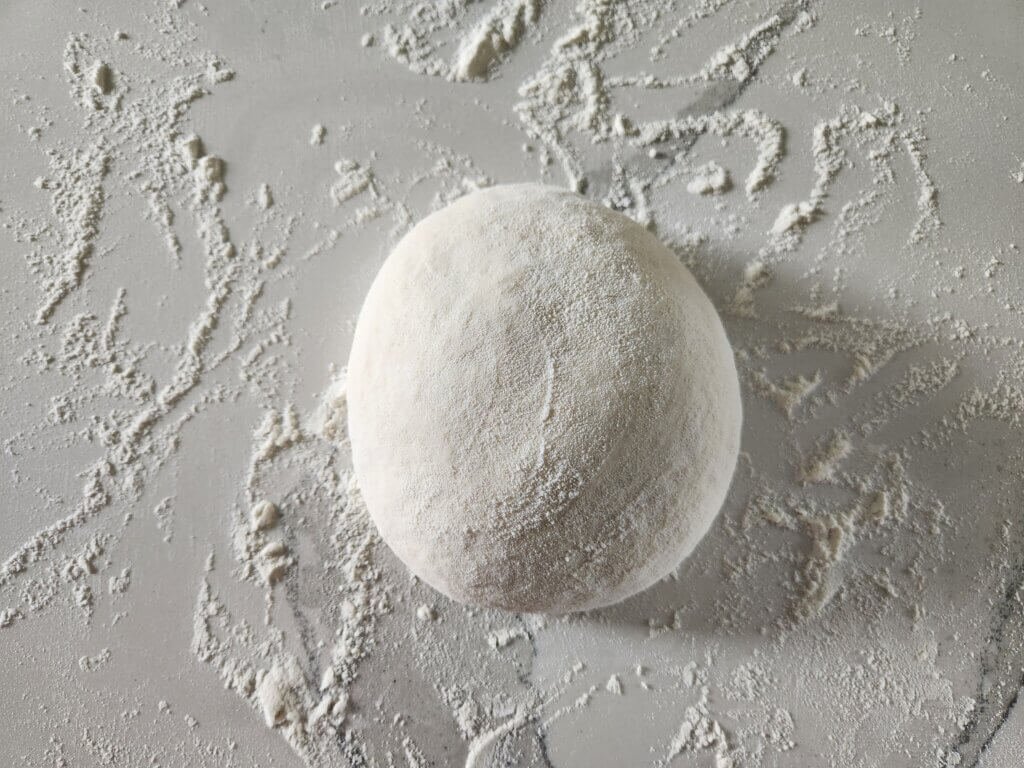
3. First Rise
Add some oil or cooking spray to the bowl you used to mix your ingredients. Place the dough in the bowl, cover it with a damp towel, and let it rise in a warm place for about 1-2 hours, or until doubled in size.


4. Shape the Dough
Prepare your baking sheet by sprinkling some flour onto it. Pour the dough out onto a floured work surface and shape it into a loaf. Video of how I shape the bread loaf is below.
Flatten the dough so it’s about 1/2 inch thick. Then fold it twice onto itself and roll it up to build some tension in the gluten strands. Fold the ends under so it’s more symmetrical and then flatten the loaf one more time. Use your thumb in the middle of the dough and fold the dough over your thumb.
This will help with more gluten development again, and help to elongate the dough making it long and evenly shaped.
5. Second Rise
Cover again, we use a silicone baking mat, and let it rise for 20 minutes. After the 20 minutes has past, preheat your oven to 375°F (190°C). Let the dough rise for another 25 minutes.
6. Bake
Score the loaf using a bread lame, or a sharp knife. You can do designs or just cut a straight line down the middle of the loaf. I like to cut 3 lines, one on each side and one down the middle. It’s all personal preference.


Bake at 375°F (190°C) for 35 minutes, until golden brown and the loaf sounds hollow when tapped.
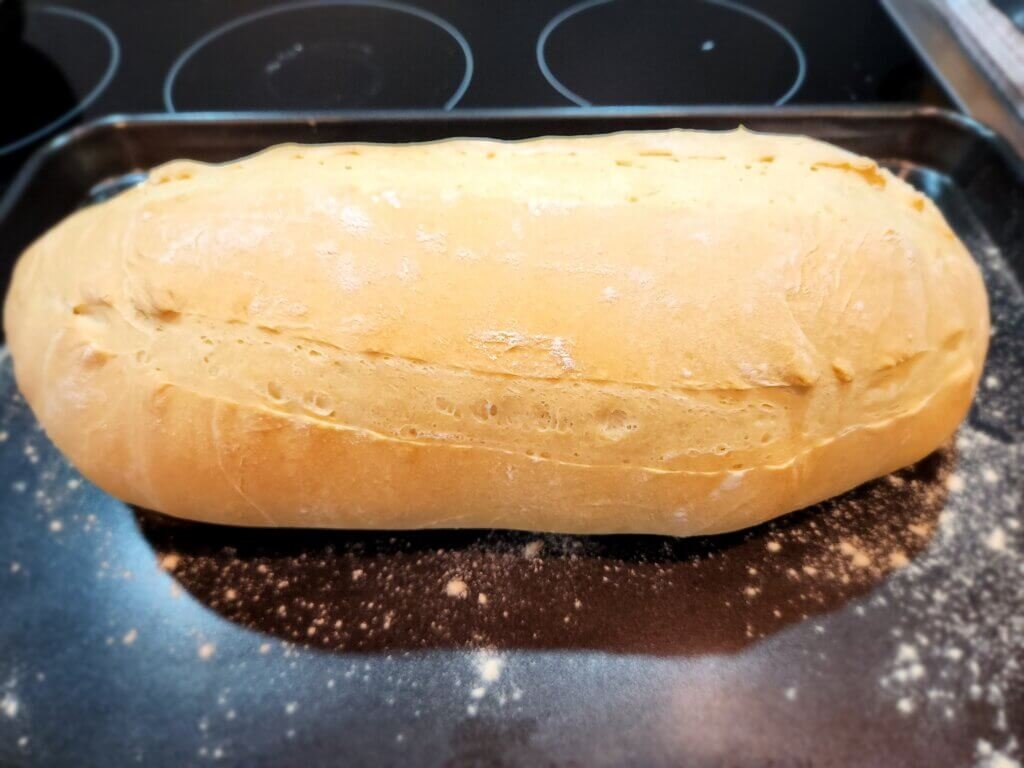
Tips for the Softest Bread
- Use milk with water for a richer loaf.
- Don’t skip the butter, it’s what gives this bread its softness.
- Avoid over-baking; once it’s golden and hollow-sounding, it’s done.
- Let it cool completely before slicing to preserve that fluffy interior.
How to Store or Freeze Soft Homemade Bread
Keep your bread in a sealed container or bread bag at room temperature for up to 3 days. For longer storage, slice and freeze it. When you’re ready to eat, just warm it in the oven or toaster, it’ll taste fresh and soft again.
Variations on This Soft Bread Recipe
Once you’ve mastered this loaf, try mixing it up:
- Honey Wheat Bread – swap half the flour for whole wheat and add extra honey.
- Cinnamon Swirl Bread – roll in cinnamon and sugar before baking.
- Garlic Herb Loaf – add minced garlic and dried herbs for a savory twist.
- Dinner Rolls – shape into rolls and bake for 15–20 minutes instead.
What Is Bread Hydration?
Bread hydration is the ratio of water to flour in a recipe. To find the hydration level simply divide the weight of the water by the weight of the flour, in this recipe it’s 330g water divided by 480g flour which equals 69%.
Most bread uses a hydration level between 60% and 75%. The higher the the hydration level the more sticky the dough will be and will result in a more open crumb. The lower the hydration the easier the dough will be to work with. Anything below 60% hydration will result in a more dense heavy loaf that is very chewy.
Higher hydration levels will result in a very sticky dough. It will also flatten out when it’s proofing which will result in a flat loaf of bread. For example, our focaccia bread recipe dough is at 90% hydration. 90% is perfect for focaccia.
We’ve found 69% is perfect for how we like our bread but this is easily customizable to your person taste.
FAQ: Soft Bread Recipe
Absolutely. Just knead by hand for 8–10 minutes until smooth and elastic.
Yes, refrigerate after the first rise and let it come to room temperature before shaping and baking.
To extend the freshness of the bread, add 1 tsp of white vinegar to the ingredients before mixing. This will help extend the freshness of the bread for another day or two.
Conclusion
Making your own soft homemade bread is easier than you might think, and once you try it, you’ll never want to go back to store-bought. This soft bread recipe gives you that perfect fluffy texture every time, ideal for sandwiches, toast, or just fresh out of the oven with butter.
So warm up your kitchen, grab your ingredients, and bake a loaf today, you’ll be hooked after the first bite.
We hope you enjoy this recipe. If you did, please rate and comment below, and make sure you check out the other recipes, as well as our growing guides, medicinal herb hub, and seed saving guides. We are growing our website with more articles all the time, and we invite you to grow with us.
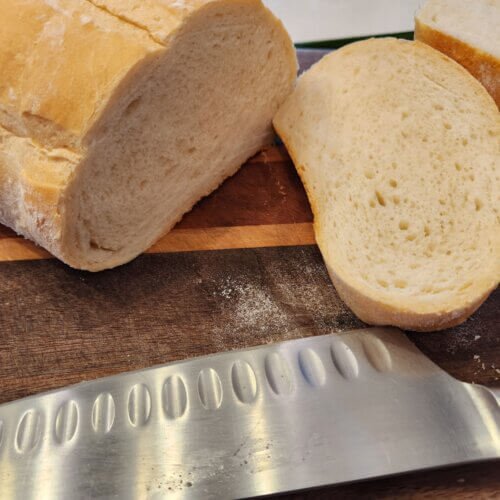
Easy Soft Bread Recipe
Equipment
- 1 Stand Mixer
- 1 Baking sheet
- 1 Oven
Ingredients
- 480 g all-purpose or bread flour
- 80 g about 1/3 cup milk
- 250 g about 1 cup warm water
- 8 g active dry yeast 1 packet
- 5 g sugar
- 5 g salt
- 30 g butter
Instructions
- Activate the Yeast (Optional Step). In the mixing bowl of a stand mixer, or large bowl, combine warm water, milk and sugar. Stir in the yeast and let it sit for about 5–10 minutes until it’s frothy. This ensures your yeast is active and ready to help your dough rise. This is only necessary when you are unsure if your yeast is active. If you make bread all the time like we do, we know the yeast we use is active so we can skip this step.
- Mix and Knead. Add the rest of the ingredients (butter, salt, and flour) to the bowl. If using a stand mixer, mix on speed 2 for 5 minutes until the dough is combined and fairy smooth. If you are not using a stand mixer, stir to combine the ingredients. Pour onto a clean work surface and knead for about 8–10 minutes until the dough is smooth and elastic.
- Remove the dough from the stand mixer using a spatula and place onto a floured surface. Knead the dough for a few seconds until is becomes very smooth and form it into a ball.
- First rise. Add some oil or cooking spray to the bowl you used to mix your ingredients. Place the dough in the bowl, cover it with a damp towel, and let it rise in a warm place for about 1-2 hours, or until doubled in size.
- Shape the Dough. Prepare your baking sheet by sprinkling some flour onto it. Pour the dough out onto a floured work surface and shape it into a loaf. Video of how I shape the bread loaf is in the article.
- Second Rise. Cover again, we use a silicone baking mat, and let it rise for 20 minutes. After the 20 minutes has past, preheat your oven to 375°F (190°C). Let the dough rise for another 25 minutes.
- Prepare to bake. Score the loaf using a bread lame, or a sharp knife. You can do designs or just cut a straight line down the middle of the loaf. I like to cut 3 lines, one on each side and one down the middle.
- Bake at 375°F (190°C) for 35 minutes, until golden brown and the loaf sounds hollow when tapped.


